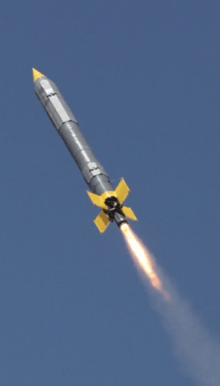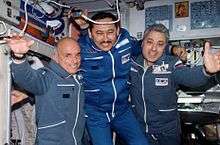Interorbital Systems
Interorbital Systems Corporation (IOS) is an American aerospace manufacturer active in Mojave, California. It was founded in 1996 by Roderick and Randa Milliron,[1] who also co-founded Trans-Lunar Research, a non-profit organization.. They aim to develop a low-cost launch vehicle for commercial purposes, by using non-aerospace components whenever possible to keep the cost down.
 | |
| Industry | Aerospace |
|---|---|
| Founded | 1996 |
| Headquarters | Mojave, California |
Key people | Rod Milliron and Randa Milliron (founders) |
| Products | rocket engines, rocket launch |
Number of employees | 12 [1] |
| Website | http://www.interorbital.com/ |
Interorbital Systems was engaged in developing a launch vehicle for the Google Lunar X Prize Team Synergy Moon[2] and for commercial launches. The company was also a competitor in the Ansari X Prize[3] and America's Space Prize.[4]
Research and development
Interorbital Systems is developing its NEPTUNE line of launch vehicles[5][1] that would launch payloads into orbit from sea platforms.
In 2016, the company website indicated they build their rockets using off-the-shelf, non-aerospace components whenever possible to keep the cost down.[1] As of 2016, the NEPTUNE system was to be Interorbital System's line of launch vehicles built from varying configurations of the Common Propulsion Module.[6]
Common Propulsion Module
As of 2011, all of Interorbital's rocket designs were based on the Common Propulsion Module (CPM). The CPM was slated to be a small, self-contained rocket system capable of delivering a 145 kg payload to an altitude of 310 km in a suborbital flight. Multiple CPMs are combined through parallel staging to meet varying mission requirements. Though they have experimented with cryogenic fuel, Interorbital used hypergolic white fuming nitric acid and Turpentine for oxidizer and fuel. The CPM is designed to maximize simplicity - its propellants are hypergolic and pressure fed, respectively eliminating the need for ignition and turbopump systems.[7]
Sounding rockets
Interorbital Systems has tested a number of rocket engines in the 500-5,000 lbf (2 to 22 kN) thrust range and conducted flight tests of its small testbed, Neutrino. Neutrino is a sounding rocket designed for low-altitude suborbital flight, for the purpose of testing systems of its larger follow-on rockets.
In 2006, IOS had an active Office of Commercial Space Transportation launch license for Tachyon,[8] a sounding rocket designed for a 120-mile apogee suborbital flight.
Preliminary design concepts
- Solaris: an early-2000s suborbital rocket design that was initially IOS' attempt to win the Ansari X Prize. It was not finished in time and was beaten by Scaled Composites' SpaceShipOne.[9]
Milestones

- The CPM's main engine underwent its first successful static engine firing on October 28, 2012. The all composite-chambered engine performed with 7,500lbs of thrust, using nitric acid and turpentine.
- The Common Propulsion Module Test Vehicle (CPM TV) performed its first successful test flight on March 29, 2014.[10] The payloads included two CubeSats, a Synergy Moon payload and a music CD by "ENCLOSURE" by former Red Hot Chili Peppers guitarist, John Frusciante.[11] The rocket reached an altitude of 10,000 feet and will be reused for the next test flight. All payloads were recovered intact.[10]
Satellite kits
- CubeSat Personal Satellite Kit comes in both a standard 1 kg (2.2 lb) and a non-standard 1.33 kg (2.93 lb) configuration. Built of an aluminum frameDesigned for simple experiments, receiving and transmitting radio signals, or for personal use.
- TubeSat Personal Satellite Kit, a lower-cost alternative to CubeSats built wholly of printed circuit boards.
They claim that kits will be launched into 310 km (192 mi) self-decaying orbits where they will eventually burn up in the Earth's atmosphere. They have a large launch manifest for both kinds of launches.[12]
Google Lunar XPrize
Interorbital Systems is engaged in June 2016 as a member of and launch provider for Team Synergy Moon in the Google Lunar X Prize competition.[13][14] The team's lunar rover was to have been lifted to the Moon's surface by a modified, 36-module version of the NEPTUNE rocket.
See also
References
- Western Pa. couple shoot to win Google Lunar XPRIZE on humble budget Archived 2018-01-24 at the Wayback Machine. 15 February 2017
- "Archived copy". Archived from the original on 2018-01-24. Retrieved 2018-01-23.CS1 maint: archived copy as title (link)
- "X PRIZE Team Summary Sheet: Interorbital Systems" (PDF). X PRIZE Foundation.
- Boyle, Alan (October 8, 2004). "Space racers set sights on orbital frontier: After X Prize, some rivals seek more lucrative payoff". NBC News. Archived from the original on December 3, 2015.
- Interorbital Preps for NEPTUNE Test Launch—and eleven smallsats will go along for the ride Archived 2018-01-24 at the Wayback Machine. Randa Milliron. SatMagazine, October 2017.
- "Launch Vehicles_1". www.interorbital.com. Archived from the original on 2016-06-02. Retrieved 2016-06-05.
- "Synergy Moon Presentation at 2011 GLXP Summit". YouTube. 2011-07-16. Archived from the original on 2015-12-03. Retrieved 2013-08-11.
- Milliron, Randa (2006-05-28). "Advantages of Using White Fuming Nitric Acid (WFNA) as an oXidizer in Rockets". Lunar Lander Challenged. Archived from the original on 2015-12-03. Retrieved 2013-08-11.
- "Space racers set sights on orbital frontier". NBC News. 2004-10-08. Retrieved 2013-08-11.
- "CPM TV Rocket Launch 03.29.14". Archived from the original on April 7, 2014. Retrieved May 6, 2014.
- "Album Launch: John Frusciante Sends New LP Into Space on Rocket". 2014-03-31. Archived from the original on 2016-07-30. Retrieved 2016-06-27.
- "Launch Manifest". Interorbital Systems. Archived from the original on 2018-01-12.
- "Lunar Missions_1". www.interorbital.com. Archived from the original on 2016-07-06. Retrieved 2016-06-05.
- "Archived copy". Archived from the original on 2018-01-24. Retrieved 2018-01-23.CS1 maint: archived copy as title (link)
